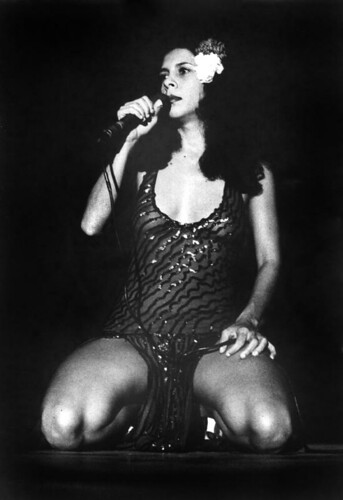'This will never end 'cause I want more
More, give me more, give me more'.
With these lines opens one of the most remarkable records of the year so far. Fever Ray (Karin Dreijer Andersson)'s "If I Had a Heart", the first of the ten tracks that make up her self-titled debut album, is ostensibly sung out of a dark place: the distorted voice sounds demonic, the title suggests a lack of humanity. Thus, Mark Pytlik of Pitchfork justly describes the song as 'a shivering, timely meditation on greed, immorality, and lust for power that dovetails nicely with AIG and Madoff '. But whatever "If I Had a Heart" may have to say about the banking crisis, I personally find its opening lyrics redolent of a wholly different concern: that of narrative. However demonic the delivery, these lines are in many ways the right way to open an album. They imply an unquenchable desire which will drive and sustain the musical narrative about to unfold. It has to end, despite the vocalist's assertion of the contrary; but it will not end before its' time: 8 songs in, Dreijer Andersson sings, 'it ain't over/I'm Not Done'.
The well-behaved Chivalric lover knew that wooing wasn't all about results. There was a finer art to be had out of "making love" in the Medieval sense - that is, courtship - than in the contemporary sense. In the most unexpected places, the influence of the Chivalric code is still felt today. It exists in every Richard Curtis film, strung out on sustained desire whose realisation signals the end of the story. It is written into the majority of serial television dramas, which defer narrative consummation by ending every episode with a brief 'Next Week On...' teaser. Wish-fulfillment is the enemy of narrative. This is why
Madame Bovary, Flaubert's 'novel about nothing', features a wedding very early on,
too early on. Boundless greed is the healthiest of narrative principles; our imaginations have been weaned on what Milan Kundera, in a short story of the same name, calls
The Golden Apple of Eternal Desire.

Two exhibitions in the recent history of Edinburgh's Fruitmarket Gallery stand out for their involvement with these issues: last summer's blockbuster, Janet Cardiff and George Bures Miller's
The House of Books Has No Windows; and Claire Barclay's
Openwide, which closed on the 12th of April. Both exhibitions used the same vocabulary of stagecraft. Barclay's exhibited works - including the specially-commissioned "Subject to Habit" (above) and the objects from across Barclay's career assembled in a sort of site-specific mini-retrospective entitled "Openwide" - looked poised for performance; their component parts resembled props from some arcane ritual. Crucially though, they never did perform for us. They remained in an elegant state of poise.
Most of Cardiff and Bures Miller's installations, on the other hand, actually did spring into activity, resembling personless dramas; uniting light, sound and found objects into short performances that were repeated over and over. They were noisy, kinetic
gestamkunstwerks, where "Openwide"was mute and inanimate. But Barclay's work was not stagnant - it required the imaginative input of the desiring viewer to give it life, to break the poise. In Cardiff and Bures Miller's "The Killing Machine" (pictured below), the desiring viewer's task was blunter and more straightforward: the poise could be broken by pressing a big red button.

Wish-fulfillment came too readily in these installations, and the result was a creeping sense - intended or otherwise - of dissatisfaction and alienation. Some of Cardiff and Bures Miller's narratives, such as "Opera for a small room", were very long; but even so they could not contain the longevity of a Claire Barclay installation, whose imagined narrative lasts as long as desire permits it. For better of for worse, Barclay's installations occupy the position of a chaste White Knight, humbly beseeching our consideration with all the thrill of ambiguity, while those of Cardiff and Bures Miller are sexual deviants with no concern for formalities. This may be why it was the latter that was selected for the festival season: amid all the surrounding hubbub, instant-yet-slightly-disappointing gratification carried more weight than chastity ever could.
It's difficult to avoid the negative connotations carried by both sides of this debate. Either we allow greed to be our guiding principle and favour the chivalrous installations of Claire Barclay, or we accept culture as just another dazzling spectacle which sates our desires before they grow monstrous, but - perhaps - weakens our imaginative faculties at the same time. Difficult, but possible. For the
Golden Apple of Eternal Desire may have left our economy in ruins, but it is also part of what makes us human, by turning us into readers and not just receptors. There is no escaping it; in art, as in love, the ellipsis will always prove more compelling than the full stop...
A different version of this article appeared in The Student, 17/02/09.Sources:
Pytlik, Mark. "Fever Ray: Fever Ray", March 20, 2009. http://pitchfork.com/reviews/albums/12845-fever-ray/ [accessed 13/05/09].
Kundera, Milan. Laughable Loves
. Kent: Faber and Faber, 1974.





















